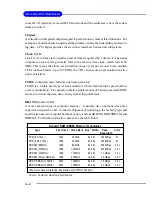
G-1
Glossary
Glossary
Glossary
ACPI
(Advanced Configuration & Power Interface)
This power management specification enables the OS (operating system) to control the
amount of power given to each device attached to the computer. Windows 98/98SE,
Windows 2000 and Windows ME can fully support ACPI to allow users managing the
system power flexibly.
AGP
(Accelerated Graphics Port)
A new, high-speed graphics interface that based on PCI construction and designed
especially for the throughput demands of 3-D graphics. AGP provides a direct channel
(32-bit wide bus) between the display controller and main memory for high graphics
quality and performance.
Bluetooth
Bluetooth refers to a worldwide standard for the wireless exchange of data between two
devices. Bluetooth requires that a low-cost transceiver chip be included in each device.
The tranceiver transmits and receives in a previously unused frequency band of 2.45
GHz that is available globally (with some variation of bandwidth in different countries).
In addition to data, up to three voice channels are available. Each device has a unique 48-
bit address from the IEEE 802 standard. Connections can be point-to-point or
multipoint. The maximum range is 10 meters. Data can be exchanged at a rate of 1
megabit per second (up to 2 Mbps in the second generation of the technology).
BIOS
(Basic Input/Output System)
On PCs, an essential software that contains all the control code of input/output inter-
face (such as keyboard, disk drives, etc.). It executes hardware test on booting the
system, starts the OS, and provides an interface between the OS and the components.
The BIOS is stored in a ROM chip.
Bus
A set of hardware lines within the computer system, through which the data is trans-
ferred among different components. In a PC, the term
bus
usually refers to a local bus
that connects the internal components to the CPU and main memory.
Cache
A special memory subsystem that is used to speed up the data transfer. It stores the






































